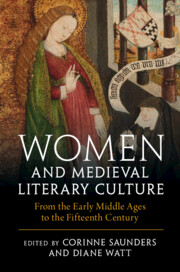Book contents
- Women and Medieval Literary Culture
- Women and Medieval Literary Culture
- Copyright page
- Contents
- Illustrations
- Contributors
- Acknowledgements
- Introduction
- I Patrons, Owners, Writers, and Readers in England and Europe
- II Circles and Communities in England
- III Health, Conduct, and Knowledge
- IV Genre and Gender
- Chapter 11 Lyrics
- Chapter 12 ‘It satte me wel bet ay in a cave / To bidde and rede on holy seyntes lyves’
- Chapter 13 Tears, Mediation, and Literary Entanglement
- Chapter 14 Convent and City
- Chapter 15 Women and Romance
- Chapter 16 Trouble and Strife in the Old French Fabliaux
- Chapter 17 Chaucer and Gower
- V Women as Authors
- General Index
- Index of Manuscripts
- References
Chapter 15 - Women and Romance
from IV - Genre and Gender
Published online by Cambridge University Press: 28 July 2023
- Women and Medieval Literary Culture
- Women and Medieval Literary Culture
- Copyright page
- Contents
- Illustrations
- Contributors
- Acknowledgements
- Introduction
- I Patrons, Owners, Writers, and Readers in England and Europe
- II Circles and Communities in England
- III Health, Conduct, and Knowledge
- IV Genre and Gender
- Chapter 11 Lyrics
- Chapter 12 ‘It satte me wel bet ay in a cave / To bidde and rede on holy seyntes lyves’
- Chapter 13 Tears, Mediation, and Literary Entanglement
- Chapter 14 Convent and City
- Chapter 15 Women and Romance
- Chapter 16 Trouble and Strife in the Old French Fabliaux
- Chapter 17 Chaucer and Gower
- V Women as Authors
- General Index
- Index of Manuscripts
- References
Summary
In this essay Corinne Saunders explores the secular genre most often associated with women, that of medieval romance, but also challenges the notion of romance as a womenߣs genre. While women were patrons, owners, readers, and even writers of courtly romances, the picture is complex: romances were often addressed to mixed audiences and read publicly rather than privately, and it is impossible to know for certain how women responded to the romance narratives that they encountered. Focusing on three central romance themes-- love and consent, virtuous suffering, and magic and enchantment ߝ this essay explores the imaginative spaces that female protagonists inhabit and the agency they demonstrate, and suggests how these might connect to ideals of Christian virtue, the constraints imposed on women by chivalry, and perhaps to the lived experiences of medieval women. Examples drawn from a range of Middle English romances, from Sir Orfeo, King Horn and Havelok the Dane to Sir Gawain and the Green Knight to Thomas Maloryߣs Morte Darthur at the very end of the period, show medieval romance as the locus of dialogue and debate about women and their place in medieval society and culture.
Keywords
- Type
- Chapter
- Information
- Women and Medieval Literary CultureFrom the Early Middle Ages to the Fifteenth Century, pp. 299 - 323Publisher: Cambridge University PressPrint publication year: 2023



